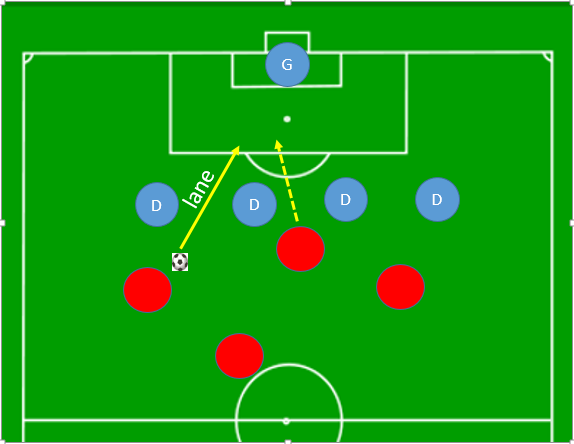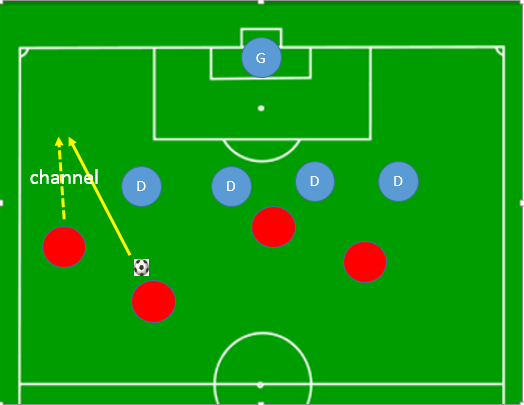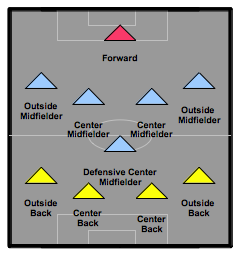|
There’s nothing more exciting than seeing a well-executed through ball that splits the defense that is anticipated by your striker who runs on to it and blasts it into the net! In recent years, teams like Barcelona, Bayern Munich and Manchester City have all gained attention for their style of play. Barca in particular (and Spain at the international level) have relied on a style that utilizes taking advantage of passing channels to create scoring opportunities. In essence, they all use possession to penetrate. The idea is to utilize passing and player movement to create gaps between defenders for attacking players to run into and for the ball to be played through- the KILLER PASS. The killer pass is the pass that creates a goal-scoring opportunity. Players that can play these combinations in and around the box become the most effective players. PASSING LANES VS. CHANNELS Passing lanes used to be called “gaps between defenders”. It is a space available for a ball to be passed through, typically on the ground. The “gap” must be wide enough so that no defender can extend the leg to cut off the pass. Or the passing distance must be short enough and the pass hard enough such that defenders don’t have time to react. The purpose is to play a ball into space behind the defense for another attacker to run into- the KILLER PASS. If it’s inside the penalty box it will set up a great scoring opportunity. Anywhere else in the field it will open up space and keep forward progression moving. A channel is most commonly referred to as the space between the most outside defender and the side line. It used to be called playing the ball down the side or the wing. From a passing technical perspective the difference between passing between two defenders or one defender and the side line is that the side line acts as a passive defender. It restricts the space available, but unlike a person, it cannot move to intercept the ball. If the situation is as in the above diagram, and the space down the side is available, a pass should follow to set the runner free and generate the cross into the penalty box. A pass on the ground will be easier to control for the receiving player, but there must be enough space to play the ball through. A ball over the top wouldn’t necessarily be called a pass into the “channel. It is easy to see how channel and lane can be used interchangeably. What matters is the concept of having space for a pass between defenders, or space for a pass between the most outside defender and the side line. Key Attacking Points:
3 Comments
Watch professional level soccer long enough and you will notice certain aspects to the game that every team performs consistently- switching the point of attack, one or two touch play, possession to produce weaknesses, using the width of the field, etc. One key aspect that isn't always discussed however, is maintaining possession in your attacking half of the field and the tactical reasons why. Once a team has built the attack out of their defensive third (post 11/27) and across the half, there are some key components to maintaining possession of the ball and player positioning on the field. Much of this is determined by the formation that the team is playing, but overall, the concepts and tactics do not change much from one formation to the next. Key Concepts:
Goalkeeper- Circulate the ball short and to free players, and support the ball near-side as an option to circulate the ball
Center Backs- Split to approximately the width of the penalty box. Shift the opposition’s first pressing line by circulating the ball to one side and then quickly shifting to the other. The center backs must move forward of the halfway line to keep the ball in the attacking half. Full Backs (Outside Backs- Get high and wide, positioning level and outside of the opposition’s first pressing line. Defensive Center Midfielder- Be positioned centrally between the two center backs and in the same horizontal line as the full backs. Attacking Midfielders- Play between the opposition lines in the midfield spaces. Attract opponents and create space in behind by dropping in front of the midfield line. Outside Midfielders- Get and maintain width with a high line of attack. Drop back to support and cover any attacking runs by the fullbacks Forward- Play between the center backs and be active in movement. Drop into available spaces to receive the ball and support attacking midfield players. The goal in attack is to score. However, it is important that other tasks be performed before that can happen. Maintaining a high defensive line- INSIDE THE ATTACKING HALF- is among the most important tactical aspects. Switching the point of attack from one side of the pitch to the other also allows for creating gaps in the defense to exploit. Tactics may vary from coach to coach. The most important thing a player can do is to listen to the coaching directions and tactical responsibilities for ALL positions. This way, the players have a clear understanding of the overall plan and approach. |
Coach Shaver"Playing the Beautiful Game" Archives
February 2019
Categories |




 RSS Feed
RSS Feed
